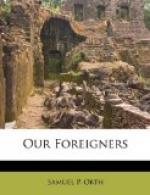[Footnote 3: Among the names which have quite vanished were those pertaining to household matters, such as Hash, Butter, Waffle, Booze, Frill, Shirt, Lace; or describing human characteristics, as Booby, Dunce, Sallow, Daft, Lazy, Measley, Rude; or parts of the body and its ailments, as Hips, Bones, Chin, Glands, Gout, Corns, Physic; or representing property, as Shingle, Gutters, Pump, Milkhouse, Desk, Mug, Auction, Hose, Tallow. Nature also was drawn upon for a large number of names. The colors Black, Brown, and Gray survive, but Lavender, Tan, and Scarlet have gone out of vogue. Bogs, Hazelgrove, Woodyfield, Oysterbanks, Chestnut, Pinks, Ragbush, Winterberry, Peach, Walnut, Freeze, Coldair, Bear, Tails, Chick, Bantam, Stork, Worm, Snake, and Maggot indicate the simple origin of many names. There were many strange combinations of Christian names and surnames: Peter Wentup, Christy Forgot, Unity Bachelor, Booze Still, Cutlip Hoof, and Wanton Bump left little to the imagination.]
[Footnote 4: These tables and those on the pages immediately following are taken from A Century of Population Growth, issued by the United States Census Bureau in 1908.]
[Footnote 5: The Scotch-Irish in America pp. 219-20.]
[Footnote 6: See The Century Magazine, September, 1891, and Lodge’s Historical and Political Essays, 1892.]
CHAPTER III
THE NEGRO
Not many years ago a traveler was lured into a London music hall by the sign: Spirited American Singing and Dancing. He saw on the stage a sextette of black-faced comedians, singing darky ragtime to the accompaniment of banjo and bones, dancing the clog and the cakewalk, and reciting negro stories with the familiar accent and smile, all to the evident delight of the audience. The man in the seat next to him remarked, “These Americans are really lively.” Not only in England, but on the continent, the negro’s melodies, his dialect, and his banjo, have always been identified with America. Even Americans do not at once think of the negro as a foreigner, so accustomed have they become to his presence, to his quaint mythology, his soft accent, and his genial and accommodating nature. He was to be found in every colony before the Revolution; he was an integral part of American economic life long before the great Irish and German immigrations, and, while in the mass he is confined to the South, he is found today in every State in the Union.
The negro, however, is racially the most distinctly foreign element in America. He belongs to a period of biological and racial evolution far removed from that of the white man. His habitat is the continent of the elephant and the lion, the mango and the palm, while that of the race into whose state he has been thrust is the continent of the horse and the cow, of wheat and the oak.




